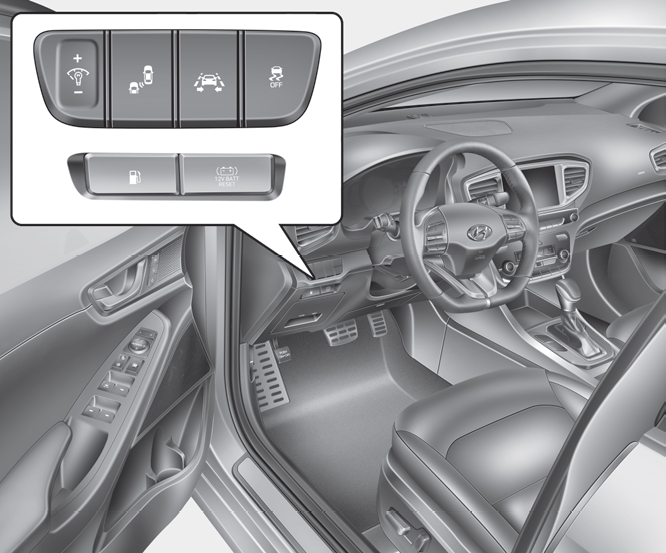Hyundai Ioniq: Fuel Delivery System / Fuel pressure test
| 1. | Release the residual pressure in fuel line. (Refer to Fuel Delivery System - "Release Residual Pressure in Fuel Line") | •
| When removing the fuel pump fuse, a Diagnostic Trouble Code (DTC) may occur. Delete the code with the GDS after completion of "Release Residual Pressure in Fuel Line" work. |
|
|
| 2. | Install the Special Service Tool (SST). | (1) | Disconnect the fuel feed tube from the high pressure fuel pump. | •
| There may be some residual pressure even after "Release Residual Pressure in Fuel Line" work, so cover the hose connection with a shop towel to prevent residual fuel from spilling out before disconnecting any fuel connection. |
|
|
| (2) | Install the special service tool for measuring the fuel pressure in between the fuel feed tube and the high pressure fuel pump. (Refer to the figure below) 
|
|
| 3. | Inspect fuel leakage on connections among the fuel feed tube, the high pressure fuel pump, and the SST components with IG ON. |
| 4. | Measure Fuel Pressure. | (1) | Start the engine and measure the fuel pressure at idle. Fuel Pressure : 495 - 505 kPa (4.9 - 5.1 kgf/cm², 71.8 - 73.2 psi) |
| •
| If the fuel pressure differs from the standard value, repair or replace the related part (Refer to the table below). |
|
Fuel Pressure
| Cause
| Related Part
| Too Low
| Fuel filter clogged
| Fuel Filter
| Fuel leakage
| Fuel Pressure Regulator
| Too High
| Fuel pressure regulator stuck
| Fuel Pressure Regulator
|
|
| (2) | Stop the engine, and then check for the change in the fuel pressure gauge reading. Standard Value : The gauge reading should hold for about 5 minutes after the engine stops |
| •
| If the gauge reading should not be held, repair or replace the related part (Refer to the table below). |
|
Fuel Pressure
(After Engine Stops)
| Cause
| Related Part
| Fuel Pressure Drops Slowly
| Leakage on injector
| Injector
| Fuel Pressure Drops Immediately
| Check valve of fuel pump stuck open
| Fuel Pump
|
|
| (3) | Turn the ignition switch OFF. |
|
| 5. | Release the residual pressure in fuel line. (Refer to Fuel Delivery System - "Release Residual Pressure in Fuel Line") | •
| When removing the fuel pump relay, a Diagnostic Trouble Code (DTC) may occur. Delete the code with the GDS after completion of "Release Residual Pressure in Fuel Line" work. |
|
|
| 6. | Test End | (1) | Remove the Special Service Tool (SST) from the fuel feed tube and the high pressure fuel pump. |
| (2) | Connect the fuel feed tube and the high pressure fuel pump. |
|
Components Location[Fuel Tank]1. Fuel tank2. Fuel pump3. Fuel filter4. Fuel pressure regulator5. Canister6. Fuel tank air Filter7. Fuel pressure sensor (FPS)8...
Release Residual Pressure in Fuel Line
•
Whenever the high pressure fuel pump, fuel pipe, delivery pipe, or injector is removed immediately after shutting off the engine, an injury may be caused by the release of highly pressurized fuel...
Other information:
GPF RegenerationThis procedures is to forcibly regenerate the GPF with scan tool when the GPF doesn't have been regenerated during driving. For example, if the vehicle has repeated "Low speed driving" or "Short distance driving", the GPF regeneration procedure cannot be proceeded because "Regeneration Mode" doesn't made...
R..
Categories

1. Door lock/unlock button
2. Driver position memory system
3. Side view mirror control switch
4. Central door lock switch
read more
 Components and components location
Components and components location Release residual pressure in fuel line
Release residual pressure in fuel line



